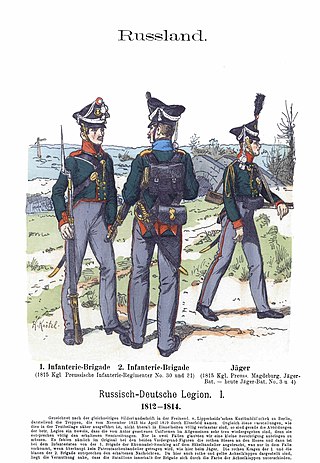Russian–German Legion
From Wikipedia, the free encyclopedia
The Russian–German Legion was a military formation of the Imperial Russian Army raised in 1812 by Peter I, Grand Duke of Oldenburg after being instigated by Alexander I of Russia.
This article needs additional citations for verification. (January 2023) |
This article includes a list of references, related reading, or external links, but its sources remain unclear because it lacks inline citations. (January 2023) |


Formation
Its first commander was Oberst von Arentsschild, and it was formed from non-French prisoners and deserters left behind in Russia during and after the French invasion earlier that year. Although called the "Russo-German Legion", the legion included Dutchmen and Belgians, who were also called up to join. Those prisoners of war wanting to join, were enlisted in the rank they had held in the French army.
It was formed to fight against Napoleon as part of the Imperial Russian army but was paid by Russia's ally, Great Britain. Ernst Moritz Arndt, the private secretary to the pro-Russian Heinrich Friedrich Karl vom und zum Stein, acted as head propagandist to entrants to the Legion. He stayed in Saint Petersburg from 1812 onwards and attracted entrants by winning them over to fight to liberate Germany from its French occupying forces.
Structure
The Russian–German Legion was 9,379 strong in total and consisted of eight infantry battalions, one company of Jägers, two regiments of hussars and two batteries of horse artillery.
Carl von Clausewitz was among notable soldiers of the Legion.
Campaigns
Summarize
Perspective
On 6 July 1812, after the contract of Peterswaldau, Great Britain received the task of providing for the Russian–German Legion and thus acquired the right to determine how and where it was to be deployed. At first, the Legion was directed southwards, where it became clear it was to be united with a Russian Corps and be deployed against the Prussians, with whom the Russians were still at war. A staff officer, Major Lager van Koch, then rode off to the Russian headquarters in Konigsberg, where he had an audience with the Czar. He soon returned with the order to march to Germany. Ludwig von Wallmoden-Gimborn was now put in command, and the Legion ventured to the lower Elbe, fought at Mecklenburg and Holstein, attacked Harburg and marched far as the Netherlands. In mid March 1814 it crossed the Rhine and fought in Flanders in order to blockade Antwerp.
After returning from France in 1814, the Legion was received by Prussia, where collaborators were viewed critically, and any non-German personnel were discharged, and so on 2 June 1814 it was renamed the German Legion. The Legion moved to Kurhessen for exercises in 1814 and from then until 1815 took up quarters in the Bergischen.
After Napoleon's return from Elba on 26 February 1815, the soldiers of this unit were merged into the 30th and 31st infantry regiment, 8th (Russisch-Deutsche Legion) Ulanenregiment and 18th and 19th horse-artillery batteries of the Prussian army. These units took part in the Waterloo campaign, known as the Hundred Days, as part of the III Corps of the Prussian Army.[1]
Several Dutch members of the Russo-German Legion had been decorated for valour. Already in 1814, several of them were given permission to wear their medals.[clarification needed] In 1821, the members of the Legion were awarded the Russian Service Medal for the wars of 1813–1814, and also given permission to wear this decoration.[clarification needed]
References
Sources
Wikiwand - on
Seamless Wikipedia browsing. On steroids.
